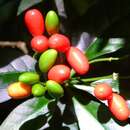Comments
provided by eFloras
Used in China to treat snake poisoning, malaria, and typhus. The roots are used to treat hypertension and as a sedative.
- license
- cc-by-nc-sa-3.0
- copyright
- Missouri Botanical Garden, 4344 Shaw Boulevard, St. Louis, MO, 63110 USA
Description
provided by eFloras
Shrubs to 3 m tall, erect, glabrous. Branchlets pale gray, lenticellate. Lower leaves opposite, terminal leaves in whorls of 3 or 4; petiole 0.5-1.5 cm; leaf blade narrowly to broadly ovate or oblong, 3.5-25 X 5-13 cm, nearly papery to membranous; lateral veins 6 or 7 pairs. Cymes rather lax, 3-9 together; peduncle 2-15 cm. Pedicel 3-6 mm. Corolla white, tube cylindric, 1-1.8 cm, inflated and villous from middle to throat; lobes broadly elliptic or ovate, 1-4.5 mm. Stamens inserted at middle of corolla tube. Ovaries distinct. Drupes ellipsoid or ovoid, distinct, ca. 10 X 5 mm. Seed 1. Fl. Feb-Oct, fr. Apr-Dec. 2n = 22*.
- license
- cc-by-nc-sa-3.0
- copyright
- Missouri Botanical Garden, 4344 Shaw Boulevard, St. Louis, MO, 63110 USA
Distribution
provided by eFloras
Guangdong, Guangxi, Guizhou, Hainan, Taiwan, Yunnan [Cambodia, India, Indonesia, Malaysia, Myanmar, Philippines, Sri Lanka, Thailand, Vietnam]
- license
- cc-by-nc-sa-3.0
- copyright
- Missouri Botanical Garden, 4344 Shaw Boulevard, St. Louis, MO, 63110 USA
Habitat
provided by eFloras
Lowland, montane rain forests, monsoon forests, brush fields, river banks, rice fields, seashores; 0-1700 m.
- license
- cc-by-nc-sa-3.0
- copyright
- Missouri Botanical Garden, 4344 Shaw Boulevard, St. Louis, MO, 63110 USA
Synonym
provided by eFloras
Dissolena verticillata Loureiro, Fl. Cochinch. 1: 137. 1790; Cerbera chinensis Sprengel; Ophioxylon chinense Hance; Rauvolfia altodiscifera Miau, R. brevistyla Tsiang; R. cambodiana Pierre ex Pitard; R. chinensis (Sprengel) Hemsley; R. latifrons Tsiang; R. perakensis King & Gamble; R. superaxillaris P. T. Li & S. Z. Huang; R. taiwanensis Tsiang; R. verticillata var. hainanensis Tsiang; R. verti-cillata var. oblanceolata Tsiang; R. verticillata var. officinalis Tsiang; R. yunnanensis Tsiang.
- license
- cc-by-nc-sa-3.0
- copyright
- Missouri Botanical Garden, 4344 Shaw Boulevard, St. Louis, MO, 63110 USA
Rauvolfia verticillata
provided by wikipedia EN
Rauvolfia verticillata, the common devil pepper,[2] is a plant in the family Apocynaceae. The specific epithet verticillata means "whorled" and refers to the plant's leaves.[3]
Description
Rauvolfia verticillata grows as a shrub up to 5 metres (20 ft) tall. The bark is yellowish black or brown. Inflorescences bear up to 35 or more flowers. The flowers feature a white or pinkish corolla. The fruits are whitish purple when ripe, ovoid, up to 1.4 cm (1 in) long.[3]
Distribution and habitat
Rauvolfia verticillata is native to China and tropical Asia from India to the Philippines. It grows in a variety of habitats, from sea-level to 2,000 metres (6,600 ft) altitude.[3]
Uses
Rauvolfia verticillata is used in traditional Chinese medicine, including as a treatment for snakebite, malaria, typhus and hypertension.[4]
References

- license
- cc-by-sa-3.0
- copyright
- Wikipedia authors and editors
Rauvolfia verticillata: Brief Summary
provided by wikipedia EN
Rauvolfia verticillata, the common devil pepper, is a plant in the family Apocynaceae. The specific epithet verticillata means "whorled" and refers to the plant's leaves.
- license
- cc-by-sa-3.0
- copyright
- Wikipedia authors and editors

